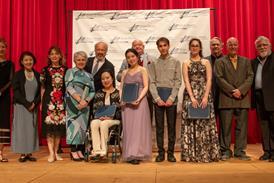In this extract from the May 1999 issue, violinist Zakhar Bron shares tips on hand shape and intonation when playing thirds in Dont Etude op.35 no.8

This is an extract from an article that appeared in the May 1999 issue. To read the article in full, click here
Lightness and agility of the left hand
There are three problems which need solving:
a) Position changes. Placement and angle of the left hand
A common mistake is the exclusive concentration of intonation without considering the placement and angle of the left hand. When the hand position is not correct, ease and agility in all positions, and thus good intonation, becomes impossible. To develop a good position I first recommend exploring thirds with the following exercise:

Finger placement should be lightly rounded (note especially the angle of the little finger) and should remain unchanged in all positions. This exercise also assists in developing sensitivity to the difference between major and minor thirds.
b) Articulation
The groups of muscles needed in the fingers for a good technique when playing thirds will best be trained by the following exercises:

To solve the problems connected with this etude, all these exercuses should be practised in every position.
c) String changes
It is important to avoid lifting the hand when crossing the strings. One finger should always remaind in contact with the string.
Good intonation
The so-called perfect intervals (unisons, fourths, fifths and octaves) are not variable. There are, however different concepts of thirds and sixths and tenths et cetera. In my opinion the differences between major and minor thirds should be clearly emphasised. Although every third in itself may be sharp, one achieves in their conjunction the acoustical effect of narrow semitones.
One should avoid intonation that opposes the physical and acoustical possibilities of the violin. For this reason I recommend the use of open strings whenever possible, including in all perfect intervals which can be built on open strings.
Read: Avoiding the ‘neutral zone’- what to do with your bow when playing violin trills
Read: Violin Masterclass: Co-ordination and Trilling in Dont’s Etude op.35 no.6
Topics
Technique: Playing with expression

How to build an emotional connection with music that shines through in every note
- 1
- 2
- 3
 Currently
reading
Currently
reading
Left-hand agility in Dont Etude op.35 no.8
- 5
- 6
- 7
- 8
- 9
- 10
























































No comments yet